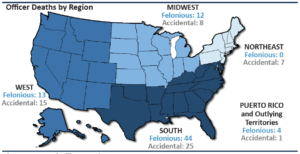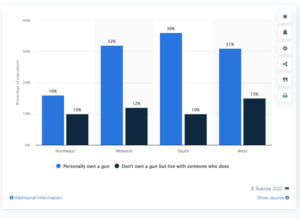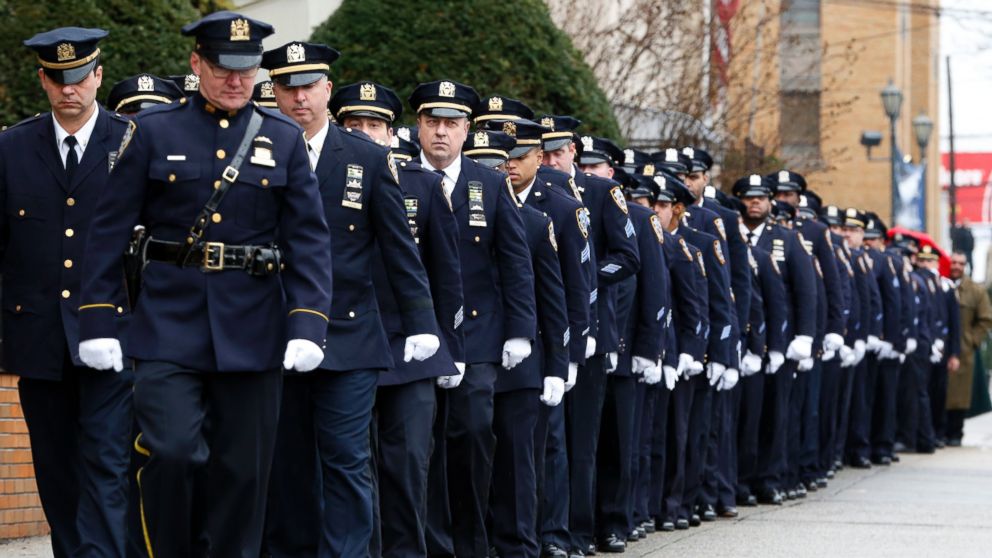It’s not easy — or safe — being a police officer in this country. Along with addressing serious issues related to shootings of unarmed African Americans and systemic racism, police officers have legitimate concerns about being shot and killed on the job as we’ve just seen with the shooting deaths of Jason Rivera and Wilbert Mora last month in New York City. In fact, almost no edition of the Weekly Toll ever goes by without at least one police officer being shot to death or run down by a car during a traffic stop or dealing with an accident.
Last year saw the largest number of line-of-duty police deaths since 1930.
Why did so many officers die last year? The right wing press, conservative commentators, and some police organizations blame the Black Lives Matter movement, pressure to “defund the police, and, of course, President Biden. The truth, as usual, is far more complicated.
How did they die?
There are two major sources for this data: the FBI’s Law Enforcement Officers Killed and Assaulted (LEOKA) database and the National Law Enforcement Memorial and Museum (NLEOMF). Both organizations report similar data. I will mostly be using the FBI data, but will note where there are significant discrepancies.
First, a record number of police officers died in the line of duty last year. According to a preliminary report from the National Law Enforcement Memorial and Museum, 458 local, state, tribal and federal officers died in the line of duty in 2021. That makes an increase of 55% from the previous year’s tally of 295.
The largest cause of deaths among police officers in 2021 was COVID-19. NLEOMF reports 301 COVID-related fatalities, more than all other causes combined (although the FBI reports “only” 257.)
Motor vehicle crashes and pedestrian fatalities have always been a major cause of police officer death.
56 officers died “accidentally” in a variety of scenarios in 2021, a 21% increase over the 47 who died accidentally in 2020. A total of 52 officers died in 2020 as a result of motor vehicle crashes or as pedestrians struck by vehicles. 31 pedestrian officers were killed, mostly by assisting or investigating a vehicle crash. 21 were the result of motor vehicle crashes. 4 officers drowned. Motor vehicle crashes and pedestrian fatalities have always been a major cause of police officer death. Over the past ten years, 481 officers died from “accidental causes (vs 503 “intentional” deaths or felonious homicides.) In 4 of the last 10 years, accidental deaths exceeded the number of intentional deaths among police officers.
The figure that were most troubling last year was the sharp increase in the number of law enforcement officers “intentionally” killed in 2021.The FBI’s LEOKA database reports 73 law enforcement officers were “feloniously killed” in the line of duty in 2021, compared with 46 in 2020, a nearly 59 percent increase. (NLEOMF reports 74 “intentional” deaths.) The last time that number was this high was 1995 when 74 officers were intentionally killed in the line of duty. The next highest number was 72 in 2011. Of the 73 officers killed by felonious assault in 2020, 61 involved firearms (83%). In 2020, 41 out of 46 felonious assaults were committed with firearms (89%).
More serious, according to the FBI’s LEOKA report, was that there were 24 “unprovoked” fatal attacks on officers, the highest total in over 30 years of reporting.
Is “Defund the Police” Killing Officers?
To what does 2021 owe this increase in line of duty police deaths? As mentioned above, the right wing press and other observers have a simple answer: Black Lives Matter and Defund the Police.
“We believe it’s a combination … of the George Floyd protests — riots, if you will; a general feeling of a preference for less law enforcement; and less prosecution and less policing,” Jason Johnson, president of the Law Enforcement Legal Defense Fund and a 20-year police veteran, told Fox News. “Law enforcement officers have essentially been marginalized and demoralized and cast aside and encouraged now to enforce the law.”
Sounds good to those who want to trash the BLM movement. But what is the real story? First, law enforcement officers don’t die in a vacuum. Last year saw a significant increase in certain types of violent crime overall. Homicides increased 5% from 2020 and 44% over 2019, according to the Council on Criminal Justice (CCJ). So in that context, an increase in police officer killings isn’t surprising, according to Chuck Wexler, the executive director of the Police Executive Research Forum (PERF), “When homicides go up, more shootings go up, and it contributes to an overall increase in violence and police officers find themselves in the middle of that environment.”
To what does 2021 owe this increase in line of duty police deaths? The right wing press and other observers have a simple answer: Black Lives Matter and Defund the Police.
And why has violent crime increased? Experts put much of the blame that COVID-19.
Job loss, illness, death, isolation, financial insecurity, fear, partisan conflict, the proliferation of dangerous conspiracy theories, extremist ideologies, and future economic or political instability and uncertainty stemming from the pandemic have pushed some to the brink. Some unemployed workers may have engaged in crime out of desperation. And many people are simply emotionally unwell: The American Psychological Association reported that there has been a widespread escalation in cases of depression and anxiety four times higher than that recorded in 2019.

Deeper analysis is obviously necessary, but other aspects of the data also cast doubt on blaming Black Lives Matters and campaigns to “defund the police.” For example, looking at the data by region reveals that 60% of felonious assault fatalities last year (44 of 73) occurred in the South, hardly a bastion of BLM or defund the police campaigns. This compares with 24 officers killed in the South in 2020, a 92% increase from 2020 to 2021. This means that almost three-quarters of the increase in intentional deaths from 2020 to 2021 were in the South.
One other note. As mentioned above, the largest number of intentional police fatalities occurred in the South. As the chart to your right shows, there were zero felonious assault deaths in the Northeast. Intentional police killings fall between those numbers in the West and Midwest.
Interestingly, if you look at gun ownership by region in the United States, according to the Pew Research Center “the southern United States has the highest amount of gun owners, with about 36% of residents living in this region owning a gun. The Midwest and West each have gun ownership levels that exceed 30%, while the Northeast has the lowest number of gun owners at about 16%.”
60% of law enforcement felonious assault fatalities last year occurred in the South, hardly a bastion of BLM or defund the police campaigns.
In other words, the regional breakdown of gun ownership correlates closely to the regional breakdown of officers intentionally killed on the job. Just saying…

Conclusion
Clearly more analysis is needed about the cause of the rise in intentional police officer killings and how to prevent them. But looking at the issue of officer deaths overall over the past two years, the most significant measure needed to protect law enforcement officers would be COVID vaccinations. Easier said than done. Despite the number of law enforcement officers who have died of COVID, police officers and other first responders are among those most hesitant to get the vaccine.
In addition, more work needs to be done to prevent vehicular crashes and pedestrian fatalities. The National Institute of Justice has teamed up with the CDC’s National Institute for Occupational Safety and Health (NIOSH) in a pilot program to investigate motor vehicle-related occupational fatalities of law enforcement officers in the U.S. NIOSH has published a number of materials concerning law enforcement officer motor-vehicle safety including incident investigations of motor vehicle crashes and officer pedestrian deaths. NLEOMF also has materials on traffic safety.
We’ll keep our eyes open for more on this topic. Watch this space.

“Defund the police” is among the stupidest slogans ever, and it has provided right-wingers with free ammunition. We Dems should be embarrassed by it. But Second Amendment yahoos should be much more shamed by the deadly impact of their senseless love of deadly weapons. These days cops not only have to worry that anyone they encounter might be armed – and that they might be outgunned. Ah, freedumb!
Half-right. Defund the police was a dumb slogan, I’m not sure who got that to stick, but dumb name for a great thought. Just as dumb is to blame guns or the right or the right=guns. Freedom is always right however.
I think that 25 percent of all people who shoot at police have mental health issues. I also remember reading that 25% of all people who are shot at by police have mental health issues. Issues of mental health need to be discussed when discussing gun violence and police.
Saul is spot on (minus the numbers—we don’t know enough to make good data) with mental health. It’s a societal issues that often rears it’s head in violent fashion in interactions with police. We need to commit to understanding more and doing more.
Breaking this down by region is next to useless. While the South, in general, is “hardly a bastion of BLM or defund the police campaigns,” certain cities within the South are very much so. Atlanta bears much more similarity to Philadelphia than it does to rural South Carolina. Has there been a spate of police killings in rural America? That would be a more helpful corroborative analysis of the extent BLM protests influence police killings than a generalized regional breakdown.
COVID provides a helpful counterpoint to the right-wing argument that the mass release of violent felons has somehow contributed to a rise in police deaths. But it would be interesting to see how that plays out in cities like Philadelphia, New York, or Los Angeles, where violence has surged far beyond national trends. Are the psychosocial effects of COVID worse in these relatively-affluent urban areas, or is it possible (outside the posited fever-swamp of right-wing hysteria) that the defunding of municipal police forces- combined with the election of prosecutors who explicitly refuse to prosecute a variety of crimes- might be a contributing factor to the localized increase in law enforcement deaths?
Which law enforcement agencies have been “defunded?”
A deeper dive into the causes reveals a lot of useful information. COVID is rarely a work-related incident; many NYS deaths are listed as 9/11–that’s BS; almost all of the vehicular incidents are due to poor training/execution of safety processes; and training itself figures in too many deaths. Policing is dangerous; everyone knows that and police receive training on how to deal with the dangers; their training and equipment >>>> the robbers. It’s a loaded question, but there is so much to unravel that can improve policing; start with the folks coming into the industry; work on training to deal with situations without deadly force; and create relationships with the policed. Too many interactions of humans with police are hostile and almost always the blue protect their own to a fault. It’s also interesting to note that another troubled public safety group: the fire department suffers from much similar issues and those two groups historically have been at odds.